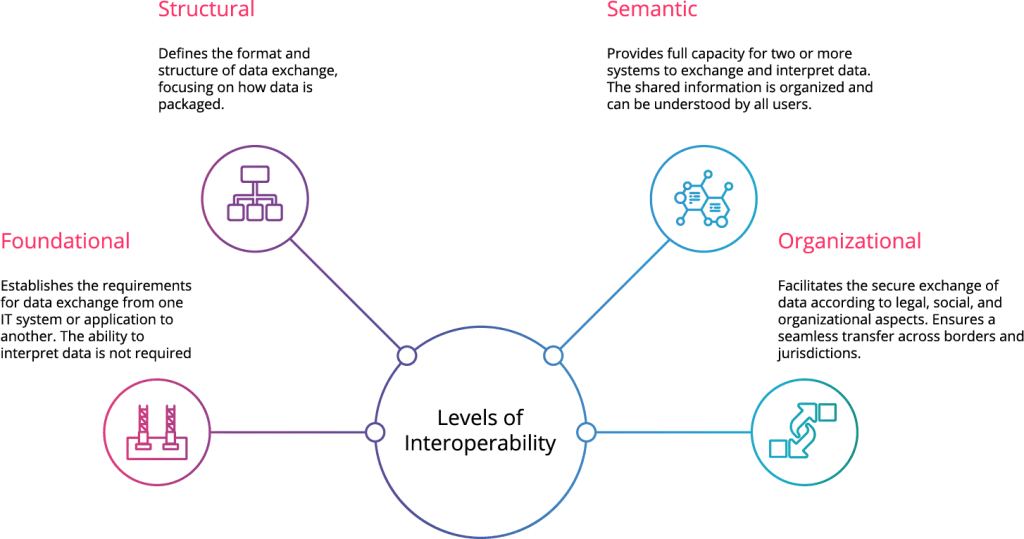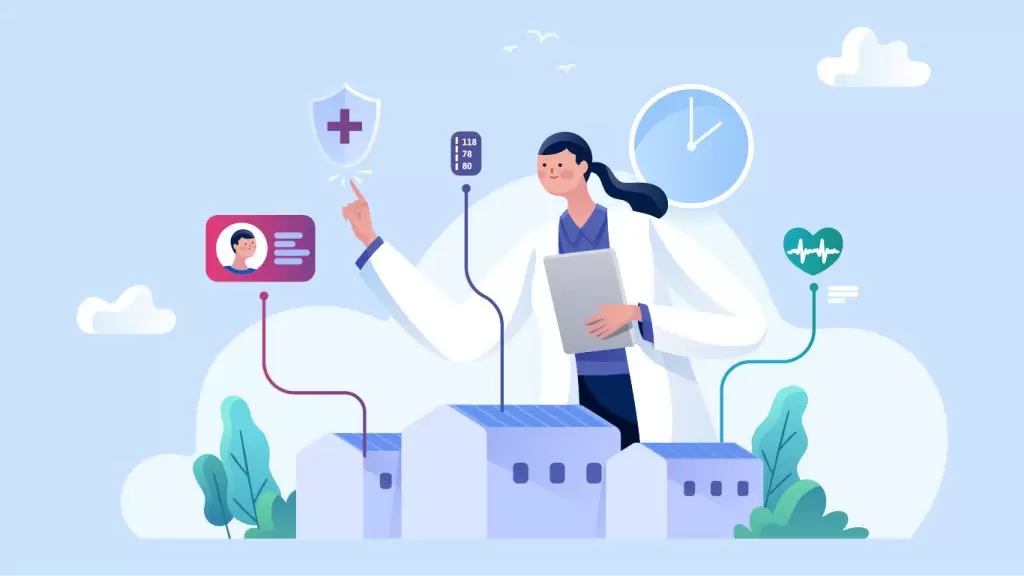-
-
-
-
URL copied!
More than 1.3 million health records are electronically requested and exchanged by St. John Providence Hospital staff. In six months or even less. To coordinate care, the medical and surgical facility chose to put in place a healthcare interoperability solution. The decision came after years of getting information via paper, fax, or telephone. Frequently, doctors needed to repeat tests because of unsynced medical records. The situation occurred even in cases where the first consultation took place in the hospital’s own ER.
The health industry is undergoing continuous change. Due to new technology capabilities, an increased volume of health data, and new regulations, health systems need to communicate and allow for a seamless transition of patient data.
To maximize value-based care and patient-driven care, the path forward for health systems is to close the gap between patients, their healthcare data, and medical staff.
Table of Contents
- What is Interoperability in Healthcare?
- Which are the Benefits of Healthcare Interoperability for Patients?
- How Difficult is it to Achieve Interoperability in Healthcare?
- Are Health Organizations Ready for Interoperability?
What is Interoperability in Healthcare?
Interoperability gives patients and physicians better access to critical health information. Electronic health records (EHRs) and other healthcare data management systems can communicate and exchange patient data due to interoperability.
HIMSS (Healthcare Information and Management Systems Society) proposed a revised definition for interoperability in healthcare in 2020. The new version includes operational data exchange. This is the first major change since 2013 when the original description was issued by HIMSS..
“It is the ability of different information systems, devices and applications (systems) to access, exchange, integrate and cooperatively use data in a coordinated manner, within and across organizational, regional and national boundaries, to provide timely and seamless portability of information and optimize the health of individuals and populations globally. Health data exchange architectures, application interfaces and standards enable data to be accessed and shared appropriately and securely across the complete spectrum of care, within all applicable settings and with relevant stakeholders, including the individual.”
To summarize, HIMSS now defines four levels of health information technology interoperability:
- foundational interoperability;
- structural interoperability;
- semantic interoperability;
- organizational interoperability.
With this new tier, data sharing becomes even more comprehensive. For the healthcare ecosystem, this means that the data exchange can extend across borders and expand globally.
Data source: Healthcare Information and Management Systems Society – himss.org
Benefits of Healthcare Interoperability for Patients
To improve patient care, current health systems must be capable of collecting new data and integrating medical information from traditional EHRs. Healthcare organizations use EHRs, but they are specific and accessible only from within. Many of them have no outside access capabilities.
The EU and the US are setting the framework for meaningful digital health interoperability. This would allow providers to exchange and examine shared data, ensuring the following benefits for patients:
- Coordination of care. With easy access to the complete picture of a patient’s medical history and health data, doctors can make informed and accurate decisions. Furthermore, patients can better focus on their healing process. Administrative tasks, like finding previous hospital records, explaining recurrent symptoms, or searching for old prescriptions, would no longer be a problem. By making EHRs the central point of the patient care process, doctors can give more accurate and coordinated treatments.
- Value-based care delivery. Healthcare providers can treat patients faster if they have real-time access to medical records. The diagnostic will also be based on statistics, insights, and tools provided by EHR. Interoperability can optimize intervention time and the medical facility’s resources.
- Patient safety. Data exchange benefits patients but also gives physicians the right information not only to treat but also to prevent. Exchanging patient data between different EHR systems and healthcare providers allows doctors to avoid diagnostic and drug prescription errors or redundant tests. By analyzing and connecting health data (for example allergies, medication information, or pre-existing conditions), care providers can detect patterns and prevent certain conditions. Physicians will be able to focus on early intervention.
- Patient privacy. Without the need to fill in dozens of forms that cross multiple hands until they reach the doctor’s desk, patients can benefit from doctor-patient confidentiality. Interoperability increases health information privacy. How? Clinical staff will no longer update medical records by hand, send them via fax, or communicate them over the telephone.
- Easy healthcare transition. Healthcare organizations now operate with various EHRs. Each one has a particular set of health data available. The key to interoperability is to standardize the data each organization is collecting, storing, and exchanging. For the patient, this will translate into a seamless transfer between healthcare providers. The medical staff will be able to continue the care process without further delays.
According to the Deloitte Center for Health Solutions, the areas that will benefit the most from greater interoperability are:
- Cost of Care (44%);
- Consumer experience (38%);
- Care coordination and patient outcomes (36%);
- Access to care (33%);
- Value-based care, payment models, and/or contracting (28%).
How Difficult it is to Achieve Interoperability in Healthcare?
Implementing interoperability in healthcare is not always a straightforward task. Organizations deal with large amounts of incoming medical data. Most of the time, the data is non-uniform and unstructured. It may come from EHRs with different formats, wearable devices, or healthcare platforms that store data from monitoring equipment.
Through a survey, the Deloitte Center for Health Solutions found out that healthcare facilities encountered several obstacles when implementing interoperability. The main concern refers to privacy and data security (51%), followed by the misalignment of data standards, semantic interoperability as HIMSS defined it (43%), and the number of disparate software vendors platforms they already use internally and externally (37%).
How to proceed with implementation as a healthcare organization? Think of the need, identify the level of interoperability that you want to achieve, do an accurate assessment of where the organization is about interoperability, and establish an ROI.
Healthcare software development companies approach an interoperability project with the data in mind. What data about patients will be accessible, in what format, from what source, who will view it? This way, the software development process is efficient and always patient-oriented.
Our custom healthcare software development teams offer a distinctive approach to interoperability. They have the HL7 FHIR® (R4) Proficiency Certificate and understand the steps, manpower, and budgetary needs required for a complex integration process. It all starts with the right estimation to overcome the challenges of multiple systems and different formats.
73% of unstructured patient data is still unavailable for analysis – Hyland Healthcare and HIMSS Media Study
Are Health Organizations Ready for Interoperability?
Health data exchange will be essential for all healthcare industry members in the next five years. Most organizations are already working on their strategic interoperability plans. This includes dedicated teams for implementation, an architecture strategy for integration, and the necessary technology capabilities for advancing interoperability (API adoption, use of the cloud, reliable IT resources, etc.).
In the US 52% of hospitals can electronically find patient health information and 38% can use or integrate data into their own EHRs, according to the Office of the National Coordinator for Health IT. The division within the US Department of Health and Human Services explored the state of interoperability across the country.
On the other hand, there is not a single common EHR system operating across all Member States of the European Union. To accelerate the adoption rate of interoperable health IT systems the EU issued a policy on the exchange of EHRs across the European Union. The decision will help shape the digital future of healthcare. The impact on patient health is at the core of the policy that seeks to establish a standard format for the European Electronic Health Record.
Organizational interoperability comes into play as both the US and EU advance with interoperability. First, with semantic interoperability, health IT developers can make sure that the different systems can share data in an organized way by creating a shared vocabulary. The additional layer ensures that the interconnectivity of digital health data can expand to a global scale.
The global market size for Healthcare Data Interoperability was valued at USD 5.5 billion in 2022 and is expected to grow at over 13% CAGR through 2023–2032. This stands as proof of the speed interoperability is picking up. Electronic health information exchange will become a real pillar for the future of healthcare.

Let’s Work Together
Related Content
Unlock the Power of the Intelligent Healthcare Ecosystem
Welcome to the future of healthcare The healthcare industry is on the cusp of a revolutionary transformation. As we move beyond digital connectivity and data integration, the next decade will be defined by the emergence of the Intelligent Healthcare Ecosystem. This is more than a technological shift—it's a fundamental change in how we deliver, experience, … Continue reading How Interoperability in Healthcare Can Improve the Patients’ Care Process →
Learn More
Crowd-Striked: Lessons Learned and Best Practices for Future Prevention
Incident Summary On July 19, 2024, CrowdStrike released a content configuration update for the Windows sensor that resulted in widespread system instability, causing Windows systems to experience the "Blue Screen of Death" (BSOD). The issue was traced to a channel file named “C-00000291*.sys” included in the update, which caused system crashes upon deployment. “Channel files” … Continue reading How Interoperability in Healthcare Can Improve the Patients’ Care Process →
Learn More
Share this page:
-
-
-
-
URL copied!

